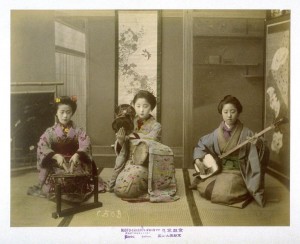
One day at Beate Gordon’s home in New York, she noticed a series of recordings on her shelf while we were examining photos for a new CD of the pianist Leo Sirota, her father.
She asked whether these discs might be of interest.
This unfamiliar set of sixty ten-inch shellac discs seemed to cover the full range of Japan’s traditions, the first volume containing the ancient shamanic court Gagaku music played by the Imperial Household ensemble, and Buddhist chant. While familiar with koto and shamisen music, I had only heard live performances and recent recordings and like the gagaku it sounded so elegant and fragile, as if it could be easily shattered, barely glued together to keep an ancient tradition alive.
Recent Gagaku:
How would these older recordings compare, as they claim that their tradition is unbroken?
Right away the presence of fewer musicians and a gripping weight, an idea of permanence leapt out of the old grooves. It sounded as if the players and their culture were part of an ancient ongoing practice that gazed into eternity, before any need to be reassembled from shards after Japan’s defeat. Every other genre, of the Noh theater, Kabuki, koto and shamisen music, folksongs, all carried a comfort and ease, a swaying rhythm hat became stratified after the country’s dismantling. Many of the performers not only represented the pre-War spirit but some were born before and trained by musicians pre-dating 1868, the moment when Japan ceased to be hermetic and foreign visitors and influences entered.
I located an extraordinary scholar, Dr. Naoko Terauchi of Kobe University who had written a comparison between the earliest (1903) gagaku and its present state. She proved to be unique in her field and amongst most ethnomusicologists who prefer writing to listening. Dr. Terauchi discovered that two known complete sets are extant; one in a library, the other Beate Gordon’s.
Beate received the discs on a military mission in Japan during her 22nd year. A fellow officer, Donald Richie, who became a leading authority on Japanese cinema, stumbled upon the set and gave it to her for safe keeping. Beate played a decisive role with the US military as they wrote in secret Japan’s postwar constitution. A native Viennese who grew up in Japan, she demanded that there be a section on women’s rights. Arguing with the military staff, she prevailed but as a young dancer, had little experience in writing a legal document. Procuring an army jeep and driver, she scoured Tokyo in search of libraries that had not been bombed. At each one she borrowed one copy of a foreign constitution along with several popular novels, doing so to avoid suspicion. Beate studied about seven documents, in seven languages, and through her work the women of Japan have a unique legal status, something that the United States and many other countries still lack. Here is Beate describing her mission (filmed in 2011).
Beate lectures on her mission and was the guiding force at the Asia Society’s arts programming for decades. She recently appeared at the Japan Society, wearing a designer dress from c. 1910 that surpassed everyone’s attire, perhaps in the entire metropolis as well that night:
Her indirect rescue of a full cross-section of traditional music, which never saw the light due to the War (possibly their warehouse was bombed), has resulted in three of a five cd series that Dr. Terauchi and I are publishing. Here is a song appearing along with its text, a sultry Geisha ballad recorded in 1940, sung by Kaneko Chieko, accompanied by Tamura Taiko, Sahashi Shôko on their shaminsen which is now in preparation for volume 4: Geisha, theater songs, children’s songs and games.
Samidare no sora ni hitokoe hototogisu. Under the May rain, a cuckoo sings.
Harete kogidasu Mokubo-ji no, When the rain stops, a boat rows out by the Mokubo-ji temple.
Sekiya hanarete Ayaseguchi. Leaving Sekiya through Ayaseguchi.
Ushida no mori wo yoko ni mite, It passed by the Ushida forest.
Koyuru ma mo naku Horikirino, Soon it reached Horikiri,
Sakuya goshaku no ayamegusa. Where tall irises gorgeously bloom.
Kyara no kaori to kono kimi sama wa, Like a scent of eaglewood,
Ikuyo tometemo washa tome akanu. I never get tired of him, even if I let him stay for a number of nights.
Netemo sametemo wasurarenu. I cannot forget him night and day.





